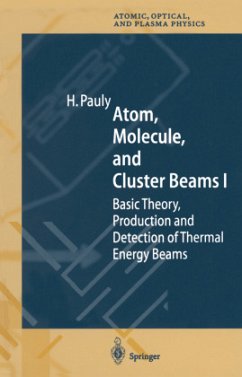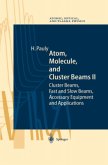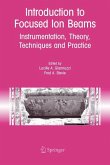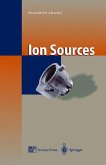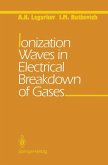Hans Pauly
Atom, Molecule, and Cluster Beams I
Basic Theory, Production and Detection of Thermal Energy Beams
Hans Pauly
Atom, Molecule, and Cluster Beams I
Basic Theory, Production and Detection of Thermal Energy Beams
- Broschiertes Buch
- Merkliste
- Auf die Merkliste
- Bewerten Bewerten
- Teilen
- Produkt teilen
- Produkterinnerung
- Produkterinnerung
This book appeals to physicists and physical chemisty being active in atom, molecule and cluster physics. It deals with the physics of gas beams.
Andere Kunden interessierten sich auch für
![Atom, Molecule, and Cluster Beams I Atom, Molecule, and Cluster Beams I]() Hans PaulyAtom, Molecule, and Cluster Beams I115,99 €
Hans PaulyAtom, Molecule, and Cluster Beams I115,99 €![Atom, Molecule, and Cluster Beams II Atom, Molecule, and Cluster Beams II]() Hans PaulyAtom, Molecule, and Cluster Beams II113,99 €
Hans PaulyAtom, Molecule, and Cluster Beams II113,99 €![Atom, Molecule, and Cluster Beams II Atom, Molecule, and Cluster Beams II]() Hans PaulyAtom, Molecule, and Cluster Beams II115,99 €
Hans PaulyAtom, Molecule, and Cluster Beams II115,99 €![Introduction to Focused Ion Beams Introduction to Focused Ion Beams]() Lucille A. Giannuzzi / Fred A. Stevie (eds.)Introduction to Focused Ion Beams166,99 €
Lucille A. Giannuzzi / Fred A. Stevie (eds.)Introduction to Focused Ion Beams166,99 €![Ion Sources Ion Sources]() Huashun ZhangIon Sources166,99 €
Huashun ZhangIon Sources166,99 €![Ion Sources Ion Sources]() Huashun ZhangIon Sources168,99 €
Huashun ZhangIon Sources168,99 €![Ionization Waves in Electrical Breakdown of Gases Ionization Waves in Electrical Breakdown of Gases]() A. N. LagarkovIonization Waves in Electrical Breakdown of Gases76,99 €
A. N. LagarkovIonization Waves in Electrical Breakdown of Gases76,99 €-
-
-
This book appeals to physicists and physical chemisty being active in atom, molecule and cluster physics. It deals with the physics of gas beams.
Produktdetails
- Produktdetails
- Springer Series on Atomic, Optical, and Plasma Physics 28
- Verlag: Springer / Springer Berlin Heidelberg / Springer, Berlin
- Artikelnr. des Verlages: 978-3-642-08623-6
- Seitenzahl: 364
- Erscheinungstermin: 1. Dezember 2010
- Englisch
- Abmessung: 235mm x 155mm x 20mm
- Gewicht: 552g
- ISBN-13: 9783642086236
- ISBN-10: 3642086233
- Artikelnr.: 32079539
- Herstellerkennzeichnung
- Springer-Verlag GmbH
- Tiergartenstr. 17
- 69121 Heidelberg
- ProductSafety@springernature.com
- Springer Series on Atomic, Optical, and Plasma Physics 28
- Verlag: Springer / Springer Berlin Heidelberg / Springer, Berlin
- Artikelnr. des Verlages: 978-3-642-08623-6
- Seitenzahl: 364
- Erscheinungstermin: 1. Dezember 2010
- Englisch
- Abmessung: 235mm x 155mm x 20mm
- Gewicht: 552g
- ISBN-13: 9783642086236
- ISBN-10: 3642086233
- Artikelnr.: 32079539
- Herstellerkennzeichnung
- Springer-Verlag GmbH
- Tiergartenstr. 17
- 69121 Heidelberg
- ProductSafety@springernature.com
1. The Role of Molecular Beams in the 20th Century.- 1.1 Historical Development.- 1.2 Main Applications of Molecular Beams.- 1.3 Thermal Energy Molecular Beam Applications in other Fields.- 1.4 Fast Beam Applications.- 1.5 Examples of Molecular Beam Machines.- 2. Fundamentals of Kinetic Gas Theory.- 2.1 Ideal Gases in Thermodynamic Equilibrium.- 2.1.1 The Maxwellian Velocity Distribution.- 2.2 Quantum Statistics.- 2.3 Molecular Flow Through an Ideal Aperture.- 2.4 Molecular Flow Through Channels.- 3. Fundamental Principles of Gas Dynamics.- 3.1 Some Fundamentals of Thermodynamics.- 3.2 Governing Equations of Steady Flow.- 3.3 One-Dimensional Flow.- 3.4 Two-Dimensional Flow.- 3.5 Free-Jet Expansion.- 3.6 The Transition to Nonequilibrium Conditions.- 3.7 Internal Energy Relaxation.- 3.8 Binary Gas Mixtures.- 3.9 Condensation and Cluster Formation.- 4. Thermal Energy Molecular Beam Sources.- 4.1 Experimental Requirements.- 4.2 Gas Sources (4-600 K).- 4.3 Ovens for Gases and Solids.- 4.4 Laser Ablation.- 4.5 Sputtering Sources.- 4.6 Recirculating Sources and Sources for Special Applications.- 4.7 Sources for Beams of Radicals.- 4.8 Production of Metastable Particles.- 4.9 Rydberg Atoms.- 4.10 Pulsed Beam Sources.- 4.11 Sources of Slow and Cold Atoms.- 5. Detection Methods.- 5.1 Accumulation Detectors.- 5.2 Momentum Detectors.- 5.3 Special Vacuum Gauges.- 5.4 Surface Ionization (Langmuir-Taylor Detector).- 5.5 Field Ionization.- 5.6 Universal Molecular Beam Detector.- 5.7 Thermal Detectors.- 5.8 Detection of Metastable Particles.- 5.9 Spectroscopic Detection Methods.- References.
1. The Role of Molecular Beams in the 20th Century.- 1.1 Historical Development.- 1.2 Main Applications of Molecular Beams.- 1.3 Thermal Energy Molecular Beam Applications in other Fields.- 1.4 Fast Beam Applications.- 1.5 Examples of Molecular Beam Machines.- 2. Fundamentals of Kinetic Gas Theory.- 2.1 Ideal Gases in Thermodynamic Equilibrium.- 2.1.1 The Maxwellian Velocity Distribution.- 2.2 Quantum Statistics.- 2.3 Molecular Flow Through an Ideal Aperture.- 2.4 Molecular Flow Through Channels.- 3. Fundamental Principles of Gas Dynamics.- 3.1 Some Fundamentals of Thermodynamics.- 3.2 Governing Equations of Steady Flow.- 3.3 One-Dimensional Flow.- 3.4 Two-Dimensional Flow.- 3.5 Free-Jet Expansion.- 3.6 The Transition to Nonequilibrium Conditions.- 3.7 Internal Energy Relaxation.- 3.8 Binary Gas Mixtures.- 3.9 Condensation and Cluster Formation.- 4. Thermal Energy Molecular Beam Sources.- 4.1 Experimental Requirements.- 4.2 Gas Sources (4-600 K).- 4.3 Ovens for Gases and Solids.- 4.4 Laser Ablation.- 4.5 Sputtering Sources.- 4.6 Recirculating Sources and Sources for Special Applications.- 4.7 Sources for Beams of Radicals.- 4.8 Production of Metastable Particles.- 4.9 Rydberg Atoms.- 4.10 Pulsed Beam Sources.- 4.11 Sources of Slow and Cold Atoms.- 5. Detection Methods.- 5.1 Accumulation Detectors.- 5.2 Momentum Detectors.- 5.3 Special Vacuum Gauges.- 5.4 Surface Ionization (Langmuir-Taylor Detector).- 5.5 Field Ionization.- 5.6 Universal Molecular Beam Detector.- 5.7 Thermal Detectors.- 5.8 Detection of Metastable Particles.- 5.9 Spectroscopic Detection Methods.- References.

